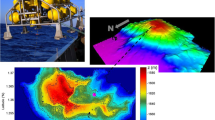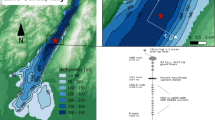Abstract
Data from the Öresund experiment are used to investigate the structure of the stably stratified internal boundary layer (SIBL) which develops when warm air is advected from a heated land surface over a cooler sea. The present study is based on a theory developed by Stull (1983a, b, c). He proposed that the turbulence and the mean structure of the nocturnal boundary layer is controlled by the time-integrated value of surface heat flux and that the instantaneous heat flux is of less importance.
Dimensional arguments are used to define simple, physically consistent, temperature, velocity and length scales. The dimensionless surface heat flux has a high value immediately downwind of the shoreline and it decreases rapidly in magnitude with increasing distance from the coast. Farther away, it is essentially constant. The dimensionless potential temperature change exhibits an exponential profile. It is estimated that turbulence accounts for 71% of boundary-layer cooling while clear-air radiational cooling is responsible for the remaining 29%.
Finally it is found that theoretical predictions for the height of the SIBL are in a good agreement with observations.
Similar content being viewed by others
References
André, J. C. and Mahrt, L.: 1982, ‘The Nocturnal Surface Inversion and Influence of Clear-air Radiative Cooling’, J. Atmos. Sci. 39, 864–878.
Brost, R. A. and Wyngaard, J. C.: 1978, ‘A Model Study of the Stably Stratified Planetary Boundary Layer’, J. Atmos. Sci. 39, 864–878.
Carlson, M. A. and Stull, R. B.: 1986, ‘Subsidence in the Nocturnal Boundary Layer’, J. Clim. Appl. Meteorol. 25, 1088–1099.
Caughey, S. J., Wyngaard, J. C., and Kaimal, J. C.: 1979, ‘Turbulence in the Evolving Stable Boundary Layer’, J. Atmos. Sci. 36, 1041–1052.
Doran, J. C. and Gryning, S. E.: 1987, ‘Wind and Temperature Structure over a Land-water-land Area’, J. Clim. Appl. Meteorol. 26, 973–979.
Garratt, J. R.: 1987, ‘The Stably Stratified Internal Boundary Layer for Steady and Diurnally Varying Offshore Flow’, Boundary-Layer Meteorol. 38, 369–394.
Garratt, J. R. and Ryan, B. F.: 1989, ‘The Structure of the Stably Stratified Internal Boundary Layer in Offshore Flow over the Sea’, Boundary-Layer Meteorol. 47, 17–40.
Gryning, S. E.: 1985, ‘The Öresund Experiment — A Nordic Mesoscale Dispersion Experiment over a Land-Water-Land Area’, Bull. Am. Meteorol. Soc. 66, 1403–1407.
Gryning, S. E. and Joffre, S.: 1987, ‘Wind Structure over the Öresund Strait’, The Öresund experiment, Proc. from Workshop II. Uppsala, October 13–14th, 1987.
Högström, U.: 1988, ‘Non-dimensional Wind and Temperature Profiles in the Atmospheric Surface Layer: Reevaluated’, Boundary-Layer Meteorol. 42, 55–78.
Hedegaard, K.: 1985, ‘Objective Analysis of Pressure Designed for Determination Geostrophic Winds’, Weather Service Report No. 4, Danish Meteorological Institute.
Launiainen, J., Grönvall, H. and Vainio, J.: 1987, ‘Marine Meteorological Conditions and Air-sea Exchange Characteristics during the Öresund-84 Experiment’, Geophysica 23(1).
Melas, D.: 1987, ‘Geostrophic Winds in the Öresund Area Determined by Objective Analysis of the Pressure Field’, The Öresund experiment, Proc. from Workshop II. Uppsala, October 13–14th, 1987.
Mulhearn, P. J.: 1981, ‘On the Formation of a Stably Stratified Internal Boundary-Layer by Advevtion of Warm Air over a Cooler Sea’, Boundary-Layer Meteorol. 21, 247–254.
Raynor, G. S., SethuRamman, S., and Brown, R. M.: 1979, ‘Formation and Characteristics of Coastal Internal Boundary Layers during Onshore Flows’, Boundary-Layer Meteorol. 16, 487–514.
Stull, R. B.: 1983a, ‘A Heat-flux-history Length Scale for the Nocturnal Boundary Layer’, Tellus 35A, 219–230.
Stull, R. B.: 1983b, ‘Integral Scales for the Nocturnal Boundary Layer, Part 1: Empirical Depth Relationships’, J. Climate Appl. Meteorol. 22, 673–686.
Stull, R. B.: 1983c, ‘Integral Scales for the Nocturnal Boundary Layer, Part 2: Heat Budget, Transport and Energy Implications’, J. Climate Appl. Meteorol. 22, 1932–1941.
Stull, R. B.: 1988, An Introduction to Boundary Layer Meteorology, pp. 504–506. Atmospheric Sciences Library, Kluwer Academic Publishers, Dordrecht, The Netherlands, 666 pp.
Author information
Authors and Affiliations
Rights and permissions
About this article
Cite this article
Melas, D. The temperature structure in a stably stratified internal boundary layer over a cold sea. Boundary-Layer Meteorol 48, 361–375 (1989). https://doi.org/10.1007/BF00123059
Received:
Issue Date:
DOI: https://doi.org/10.1007/BF00123059




